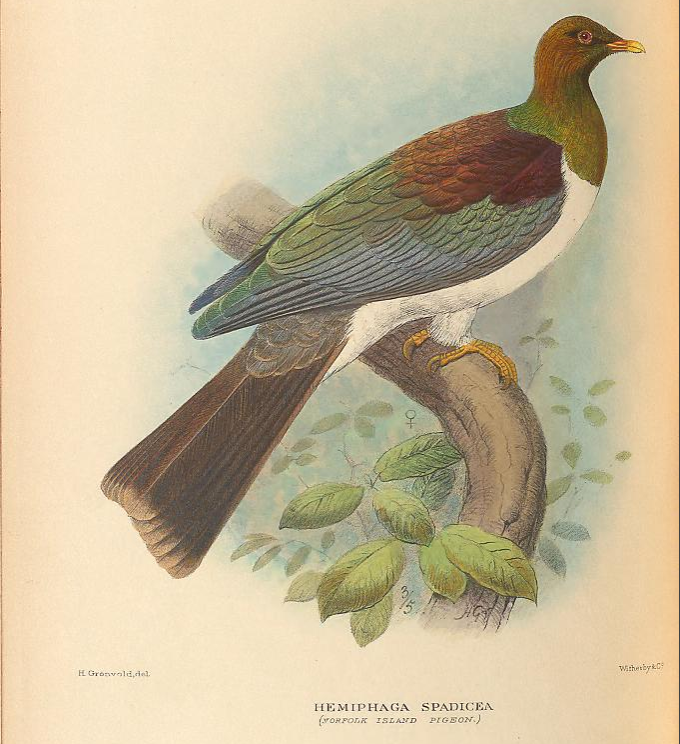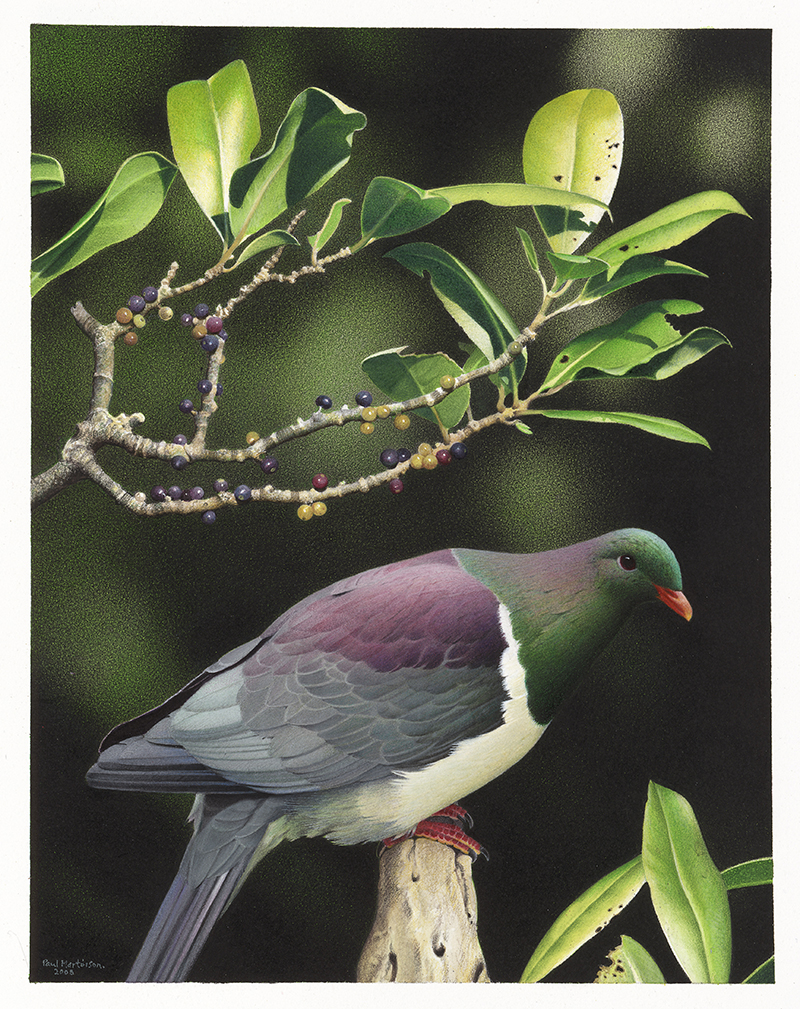Hemiphaga spadicea Latham, 1802
Norfolk Island pigeon, Wood quest, Chestnut shouldered pigeon (archaic)
Taxonomy & Nomenclature
A complete synonymy taken from (Checklist Committee (OSNZ), 2010:248):
Columba spadicea Latham, 1802: Index Ornith. Suppl.: lx, no 7 – Norfolk Island.; Columba gigas Ranzani, 1821: Elementi Ornitologia, in Elementi Zoologia 3(1): 223. Unnecessary nomen novum for Columba spadicea Latham, 1802.; Columba leucogaster Wagler, 1827: Syst. Avium, Columba: sp. 12. Unnecessary nomen novum for Columba spadicea Latham, 1802.; Columba princeps Vigors, 1833: Proc. Zool. Soc. London 1833 (1): 78 – Australia, restricted to Norfolk Island.; Carpophaga spadicea (Latham); G.R. Gray 1862, Ibis 4: 232.; Hemiphaga novaeseelandiae spadicea (Latham); Mathews 1913, List Birds Australia: 326.; Hemiphaga argetraea (J.R. Forster); Iredale 1937, Emu 37: 99. Not Columba argetraea J.R. Forster, 1794.; Hemiphaga spadicea (Latham); Holdaway, Worthy & Tennyson 2001, New Zealand Journ. Zool. 28(2): 134, 179.
Conservation Status
Extinct
Last record: 21 March 1839 (Taylor, 1966); 1850's (Hume & Walters, 2012:164); 1900 (Schodde et al. 1983) or 1901 (Day, 1989)
IUCN RedList status: Extinct
Distribution
Norfolk Island, Australia
Biology & Ecology
Hypodigm
"RMNH 87749: adult. Norfolk Island. From: Cabinet Temminck. Holotype, Columba gigas Ranzani, 1821.
RMNH 110.112: adult. Norfolk Island. Probably from: Cabinet Temminck.
RMNH 110.094: adult. Origin unknown (= Norfolk Island)."
Source: http://nlbif.eti.uva.nl/naturalis/detail.php?lang=uk&id=41
Media

Above: plate from Mathews (1928).

Above: Norfolk Island Pigeon. Hemiphaga spadicea. From the series: Extinct Birds of New Zealand., 2005, Masterton, by Paul Martinson. Purchased 2006. © Te Papa. CC BY-NC-ND 4.0. Te Papa (2006-0010-1/54)
References
Original scientific description:
Latham, J. A. (1801b). Index Orntihologicus, supplement. London: Leigh, Sotheby & Son.
Other references:
Backhouse, J. 1843. Narrative of a visit to the Australian colonies. London: Hamilton, Adams. 560 pp.
BirdLife International. (2012). Species factsheet: Hemiphaga spadicea. Downloaded from http://www.birdlife.org on 25/11/2012.
BirdLife International. (2012). Hemiphaga novaeseelandiae. In: IUCN 2012. IUCN Red List of Threatened Species. Version 2012.2. (http://www.iucnredlist.org). Downloaded on 25 November 2012.
Brooks, T. (2000). Extinct species. In: BirdLife International (ed.), Threatened birds of the world, pp. 701-708. Lynx Edicions and BirdLife International, Barcelona and Cambridge, U.K.
Browning, M. R. and Monroe, B. L. (1991). Clarifications and corrections of the dates of issue of some publications containing descriptions of North American birds. Archives of Natural History 18: 381-405.
Checklist Committee (OSNZ). (2010). Checklist of the Birds of New Zealand, Norfolk and Macquarie Islands, and the Ross Dependency, Antarctica (4th ed.). Ornithological Society of New Zealand & Te Papa Press, Wellington. [p. 248]
Day, David. (1981). The Doomsday Book of Animals: A Natural History of Vanished Species. New York, N.Y.: The Viking Press. [erroneously lists the last sighting as 1801, which was rectified in (Day, 1989)]
Day, David. (1989). The Encyclopedia of Vanished Species. Hong Kong: Mclaren Publishing Limited.
Garnett, Stephen (ed.). (1992). Threatened and Extinct Birds of Australia. RAOU Report Number 82. 212 pp.
Garnett, S. T. and Crowley, G. M. (2000). The Action Plan for Australian Birds 2000. Canberra, ACT: Environment Australia & Birds Australia.
Gibbs, D., Barnes, E. and Cox, J. (2001). Pigeons and doves. Robertsbridge, Sussex: Pica Press.
Gill B.J.; Bell, B.D.; Chambers, G.K.; Medway, D.G.; Palma, R.L.; Scofield, R.P.; Tennyson, A.J.D.; Worthy, T.H. 2010. Checklist of the birds of New Zealand, Norfolk and Macquarie Islands, and the Ross Dependency, Antarctica. 4th edition. Wellington, Te Papa Press and Ornithological Society of New Zealand.
Higgins, P. J. and Davies, S. J. J. F. (eds) 1996. Handbook of Australian, New Zealand and Antarctic Birds. Vol. 3. Snipe to Pigeons. Oxford University Press, Melbourne.
Holdaway, Richard N. and Anderson, Atholl. (2001). Avifauna from the Emily Bay settlement site, Norfolk Island: A preliminary account, pp. 85-100. In: Anderson, Atholl and White, Peter (eds.). Records of the Australian Museum, Supplement 27. Sydney: Australian Museum.
Holdaway, Richard N., Worthy, Trevor H. and Tennyson, Alan J. D. (2001). A working list of breeding bird species of the New Zealand region at first human contact. New Zealand Journal of Zoology 28: 119-187.
Hull, Arthur Francis Basset. (1909). The birds of Lord Howe and Norfolk Islands. Proceedings of the Linnean Society of New South Wales 34: 636-693, pls. l-liv. [p. 642]
Hume, Julian Pender and Walters, Michael. (2012). Extinct Birds. London: T & AD Poyser. 544 pp.
Iredale, T. 1937. J. R. & G. Forster, naturalists. Emu 37: 95-99.
Knox, Alan G. and Walters, Michael P. (1994). Extinct and endangered birds in the collections of The Natural History Museum. British Ornithologists' Club Occasional Publications 1: 1-292. [pp. 144-145]
Latham, J. A. (1801a). General Synopsis of Birds; Supplement. Volume 2. Winchester.
Mathews, Gregory Macalister. (1928). The Birds of Norfolk & Lord Howe Islands and the Australasian South Polar Quadrant: with additions to "birds of Australia". London: H.F. & G. Witherby. [p. 1, pl. 1]
Mathews, G.M. 1936. A supplement to the birds of Norfolk and Lord Howe Islands to which is added those birds of New Zealand not figured by Buller. London: published by the author. 177 pp.
Mathews, G. M. (1946). A working list of the Australian birds, including the Australian Quadrant and New Zealand. Shepherd & Newman, Sydney.
Matthews, Thomas J. et al. (2022). Threatened and extinct island endemic birds of the world: Distribution, threats and functional diversity. Journal of Biogeography. https://doi.org/10.1111/jbi.14474
McAllan, Ian A. W. (1999). A common name for the Norfolk Island Pigeon. Australian Bird Watcher 18: 179-180.
McAllan, Ian A. W. (2007). Existing usage and the names of some Australian birds. Bulletin of the British Ornithologists' Club 127(2): 136-145.
McNamara, E. (1937). Birds of the Blackberries. Emu 37(2): 99-102. [relevant citation?]
Moore, James L. (1985). Ensign Best's bird observations on Norfolk Island. Notornis 32: 319-322.
Peale, T. R. (1848). Mammalogy and Ornithology. United States Exploring Expedition During the Years 1838, 1839, 1840, 1841, 1842. Under the Command of Charles Wilkes, USN. Philadelphia: C. Sherman.
Rothschild, Lionel Walter. (1907). Extinct birds: an attempt to write in one volume a short account of those birds which have become extinct in historical times, that is within the last six or seven hundred years: to which are added a few which still exist, but are on the verge of extinction. London: Hutchinson & Co. XXIX + 243 pp. [p. 161, pl. 21]
Salvadori, T. 1893. Catalogue of the Columbae, or pigeons. Catalogue of the birds in the British Museum. Volume 21. London: The Trustees, British Museum (Natural History). xvii + 676 pp., 15 pls.
Schodde, R., Fullagar, P. and Hermes, N. (1983). A review of Norfolk Island birds: past and present. Australian National Parks and Wildlife Service, Canberra.
Schodde, R. & Mason, I. J. 1997. Zoological catalogue of Australia, vol. 37.2. CSIRO Publishing, Melbourne.
Stattersfield, A. J., Crosby, M. J., Long, A. J. and Wege, D. C. (1998) Endemic bird areas of the world: priorities for bird conservation. Cambridge, U.K.: BirdLife International (BirdLife Conservation Series 07).
Steinheimer, F.D.; Schodde, R. & Bock, W.J. 2008. Application of the new names in the 1794 J.R. Foster footnote on Norfolk Island birds. Notornis 55: 32–37.
Taylor, N.M. (Ed.). 1966. The journal of Ensign Best 1837–1843. Wellington: Government Printer. 465 pp.
Tyrberg, Tommy. (2009). Holocene avian extinctions, pp. 63-106. In: Turvey, Samuel T. (ed.). Holocene Extinctions. Oxford, UK & New York, USA: Oxford University Press. xii + 352 pp.
Vigors, N. A. (1833). [Untitled]. Proceedings of the Zoological Society of London [1833](1): 78.
Woinarski, John C. Z., Legge, Sarah M. and Garnett, Stephen T. (2024). Extinct Australian birds: numbers, characteristics, lessons and prospects. Emu 124(1): 8-20. https://doi.org/10.1080/01584197.2023.2240345
http://en.wikipedia.org/wiki/Norfolk_Pigeon
http://books.google.com.au/books?hl=en&lr=&id=KixK4CZQZp0C&oi=fnd&pg=PP1&ots=6OAtdS7Poo&sig=I75-kDP43Q5rKzpLU_PqwprwOd0#v=onepage&q&f=false
http://piclib.nhm.ac.uk/results.asp?image=005137
https://extinctanimals.proboards.com/thread/8179/hemiphaga-spadicea-norfolk-island-pigeon
https://www.biodiversitylibrary.org/item/210858#page/9/mode/1up
